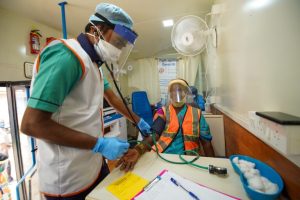72 Diagnosis and Detection

Healthcare providers analyze a sample of tissue or body fluid blood, stool, sputum, and throat and mouth mucus, to diagnose zoonotic diseases (Cleveland Clinic 2023). In some cases, based on your symptoms, healthcare providers may also require imaging tests such as a chest X-ray or CT scan to evaluate any internal impacts of the infection (World Health Organization 2023). They send the sample to a lab, where it is tested for bacteria, viruses, fungi, or parasites. Serological tests for antibodies, molecular tests by PCR for genetic material from the pathogen, or cultures to grow and identify the infectious agent may help further diagnose and assess the specific illness (Cleveland Clinic 2023). If specific pathogens are present, then it is confirmed that there is a zoonotic disease. Further testing may be needed, in some cases, to determine the specific strain of the disease, its severity, or its resistance to treatment (World Health Organization 2023). It is essential to have appropriate medical guidance in a timely manner to prevent even greater transmission (World Health Organization 2023).
Identifying and diagnosing zoonotic diseases comes with many challenges. There is a weak disease surveillance system overall, making it very difficult to track down and identify these diseases (World Health Organization 2023). Zoonotic hosts thrive in remote areas, which makes field investigations more challenging. Between countries, there is inadequate information and surveillance exchange, so much information is lost (Emerging and Reemerging Infectious Diseases 2016). Community engagement is also a primary issue, which makes it hard to control the zoonotic spread of disease (Emerging and Reemerging Infectious Diseases 2016). Identifying zoonotic diseases can be very challenging due to a lack of surveillance, inadequate reporting, and a lack of communication between sectors.
To prevent yourself from getting infected with a zoonotic disease, you need to follow proper protocols. Staying up to date on vaccines, protecting against bug bites with long-sleeved clothes and bug spray, wearing gloves while handling animals, preparing food safely when cooking animal meat, avoiding infected bodily fluids, and avoiding bush meat are among them (Cleveland Clinic 2023). It’s also important to wash your hands regularly with soap and water, especially after touching animals or being in places where they are kept. Vaccinating pets against zoonotic diseases, as well as ensuring they are regularly dewormed, can also help reduce the risk of disease transmission. Reducing exposure risks also comes from avoiding direct contact with wild animals, properly disposing of animal waste, and keeping living and working places clean. For those working with animals, protective gear and biosecurity protocols can add extra layers of safety. Following these preventative measures can greatly lessen your risk of contracting a zoonotic disease (Cleveland Clinic 2023). (E.B.)
If you do end up getting infected with a zoonotic disease, there are essential steps you can take to protect others. For starters, keep your distance from others and animals to prevent spreading the infection. After handling animals or their environments—or after contact with secretions—wash hands thoroughly with soap (preferably liquid soap) and water (World Health Organization 2023). Cleaning and disinfecting areas where animals are kept, such as pens or feeding areas, is also critical. Report your infection to your local health department and, if necessary, animal health authorities. This enables them to monitor how diseases spread. Don’t forget to see a doctor. They can advise and treat you as needed, inform you if you’re prescribed any medication, and tell you how long to avoid contact with others and what safety measures to follow (World Health Organization 2023). That helps keep everyone safe and helps slow the spread of these illnesses. (E.B.)
